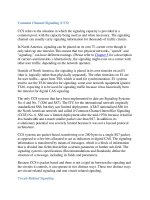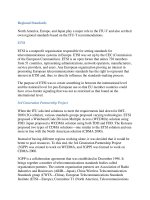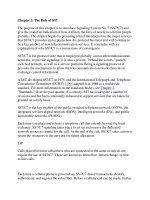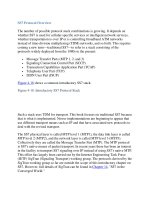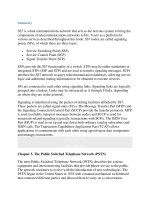Signaling System No.7 Protocol Architecture And Sevices part 7 potx
Bạn đang xem bản rút gọn của tài liệu. Xem và tải ngay bản đầy đủ của tài liệu tại đây (55.46 KB, 10 trang )
Chapter 3. The Role of SS7
The purpose of this chapter is to introduce Signaling System No. 7 (SS7/C7) and
give the reader an indication of how it affects the lives of nearly two billion people
globally. The chapter begins by providing a brief introduction to the major services
that SS7/C7 provides and explains how the protocol has been and will continue to
be a key enabler of new telecommunication services. It concludes with an
explanation of why SS7/C7 is a cornerstone of convergence.
SS7/C7 is the protocol suite that is employed globally, across telecommunications
networks, to provide signaling; it is also a private, "behind the scenes," packet-
switched network, as well as a service platform. Being a signaling protocol, it
p
rovides the mechanisms to allow the telecommunication network elements to
exchange control information.
AT&T developed SS7/C7 in 1975, and the International Telegraph and Telephone
Consultative Committee (CCITT) [109
] adopted it in 1980 as a worldwide
standard. For more information on the standards bodies, see Chapter 2
,
"Standards." Over the past quarter of a century, SS7 has undergone a number of
revisions and has been continually enhanced to support services that are taken for
granted on a daily basis.
SS7/C7 is the key enabler of the public switched telephone network (PSTN), the
integrated services digital network (ISDN), intelligent networks (INs), and public
land mobile networks (PLMNs).
Each time you place and release a telephone call that extends beyond the local
exchange, SS7/C7 signaling takes place to set up and reserve the dedicated
network resources (trunk) for the call. At the end of the call, SS7/C7 takes action to
return the resources to the network for future allocation.
TIP
Calls placed between subscribers who are connected to the same switch do not
require the use of SS7/C7. These are known as intraoffice, intraexchange, or line-
to-line calls.
Each time a cellular phone is powered up, SS7/C7-based transactions identify,
authenticate, and register the subscriber. Before a cellular call can be made, further
transactions check that the cellular phone is not stolen (network dependent option)
and qualify permission to place the call (for example, the subscriber may be barred
from International usage). In addition, the SS7/C7 network tracks the cellular
subscriber to allow call delivery, as well as to allow a call that is already in
p
rogress to remain connected, even when the subscriber is mobile.
Although the average person typically uses SS7/C7 several times a day, it is
largely unheard of by the general public because it is a "behind the scenes" private
network—in stark contrast to IP. Another reason for its great transparency is its
extreme reliability and resilience. For example, SS7/C7 equipment must make
carrier grade quality standards—that is, 99.999 percent availability. The three
p
rime ways it achieves an industry renowned robustness is by having a protocol
that ensures reliable message delivery, self-healing capabilities, and an over-
engineered physical network.
Typically, the links that comprise the network operate with a 20–40 percent
loading and have full redundancy of network elements. SS7/C7 might well be the
most robust and reliable network in existence.
SS7/C7 is possibly the most important element from a quality of service (QoS)
p
erspective, as perceived by the subscriber.
N
OTE
Here QoS refers to the quality of services as perceived by the subscriber. It should
not be confused with QoS as it relates specifically to packet networks.
QoS is quickly becoming a key in differentiating between service providers.
Customers are changing service providers at an increasing pace for QoS reasons,
such as poor coverage, delays, dropped calls, incorrect billing, and other service-
related impairments and faults. SS7/C7 impairments nearly always impact a
subscriber's QoS directly. A complete loss of signaling means a complete network
outage, be it a cellular or fixed-line network. Even a wrongly-provisioned
screening rule at a SS7/C7 node in a cellular network can prohibit subscribers from
roaming internationally or sending text messages. A loss of one signaling link
could potentially bring down thousands of calls. For this reason, the SS7/C7
network has been designed to be extremely robust and resilient.
Impact of SS7 Network Failure
The critical nature of the SS7 network and the potential impact of
failures was demonstrated in January 1990 when a failure in the SS7
software of an AT&T switching node rippled through over 100 switching
nodes. The failure caused a nine-hour outage, affecting an estimated
60,000 people and costing in excess of 60 million dollars in lost revenue
as estimated by AT&T.
< Day Day Up >
< Day Day Up >
Signaling System No. 7-Based Services
In addition to setting up and releasing calls, SS7/C7 is the workhorse behind a
number of telecommunication services, including:
• Telephone-marketing numbers such as toll-free and freephone
• Televoting (mass calling)
• Single Directory Number
• Enhanced 911 (E911)—used in the United States
• Supplementary services
• Custom local area signaling services (CLASS)
• Calling name (CNAM)
• Line information database (LIDB)
• Local number portability (LNP)
• Cellular network mobility management and roaming
- Short Message Service (SMS)
- Enhanced Messaging Service (EMS)— Ringtone, logo, and cellular game
delivery
• Local exchange carrier (LEC) provisioned private virtual networks (PVNs)
• Do-not-call enforcement
The following sections describe these telecommunications services.
Telephone-Marketing Numbers
The most commonly used telephone-marketing numbers are toll-free calling
numbers (800 calling), known as freephone (0800) in the United Kingdom.
Because the call is free for the caller, these numbers can be used to win more
business by increasing customer response. Telephone-marketing numbers also
p
rovide premium rate lines in which the subscriber is charged at a premium in
exchange for desired content. Examples of such services include adult services and
accurate road reports.
Another popular telephone-marketing number is local call, with which a call is
charged as a local call even though the distance might be national. In recent years
in the United Kingdom, marketing numbers that scarcely alter the call cost have
been a popular means of masking geographical location. These numbers allow for
a separation between the actual number and the advertised number.
Televoting
Televoting is a mass calling service that provides an easy method of surveying the
p
ublic on any imaginable subject. The host (for example, a deejay at a radio
station) presents specific questions and the caller uses a telephone keypad to select
a choice; the caller's action adds to the vote for that particular choice. The
conversation phase is usually limited to a simple, automated "thank you for…"
p
hrase. Televoting can also be used in many other areas, such as responding to
fundraising pleas and telephone-based competitions. A single night of televoting
might result in 15 million calls [110
]. Televoting services represent some of the
most demanding—as well as lucrative—call scenarios in today's telephone
networks. Revenue generation in this area is likely to grow as customers shift more
toward an "interactive" experience, on par with convergence.
S
in
g
le Directory Number
Another service that uses SS7/C7 and has been deployed in recent years is the
single directory number, which allows a company with multiple offices or store
locations to have a single directory number. After analyzing the calling party's
number, the switch directs the call to a local branch or store.
E
nhanced 911
E911, which is being deployed across some states in the United States, utilizes SS7
to transmit the number of the calling party, look up the corresponding address of
the subscriber in a database, and transmit the information to the emergency
dispatch operator to enable a faster response to emergencies. E911 might also
p
rovide other significant location information, such as the location of the nearest
fire hydrant, and potentially the caller's key medical details. The Federal
Communications Commission (FCC) also has a cellular 911 program in progress;
in addition to providing the caller's telephone number, this program sends the
geographical location of the antenna to which the caller is connected. Enhancement
p
roposals are already underway to obtain more precise location information.
S
upplementar
y
Services
Supplementary services provide the subscribers with more than plain old telephony
service (POTS), without requiring them to change their telephone handsets or
access technology. Well-known supplementary services include three-way calling,
calling number display (CND), call-waiting, and call forwarding. Note that the
exact names of these services might differ, depending on the country and the
operator.
Recently, supplementary services have been helpful in increasing operators'
revenues since revenues against call minutes have been on the decline. Usually the
subscriber must pay a fixed monthly or quarterly fee for a supplementary service.
Custom Local Area Signaling Services (CLASS)
Custom local area signaling services (CLASS) are an extension of supplementary
services that employ the use of SS7 signaling between exchanges within a local
geographical area. Information provided over SS7 links, such as the calling party
number or the state of a subscriber line, enable more advanced services to be
offered by service providers. A few examples of CLASS services include:
• Call block— Stops pre-specified calling party numbers from calling.
• Distinctive ringing— Provides a distinct ringing signal when an incoming
call originates from a number on a predefined list. This feature is particularly
beneficial to households with teenagers.
• Priority ringing— Provides a distinct ring when a call originates from a pre-
specified numbers. If the called subscriber is busy and has call waiting, the
subscriber receives a special tone indicating that a number on the priority list
is calling.
• Call completion to busy subscriber (CCBS)— If a subscriber who has CCBS
calls a party who is engaged in another call, the subscriber can activate
CCBS with a single key or sequence. When activated, CCBS causes the
calling party's phone to ring when the called party becomes available; when
the calling party answers, the called party's phone automatically rings again.
This feature saves the calling party from continuously attempting to place a
call to a party is still unavailable.
N
ote that the exact names of these services might differ, depending on the country
and the operator. In addition, the term "CLASS" is not used outside of North
America.
Calling Name (CNAM)
Calling name (CNAM) is an increasingly popular database-driven service that is
only available in the United States at this time. With this service, the called party
receives the name of the person calling in addition to their number. The called
p
arty must have a compatible display box or telephone handset to use this service.
The CNAM information is typically stored in regional telecommunications
databases. SS7/C7 queries the database for the name based on the number and
delivers the information to the called party's local switch.
L
ine In
f
ormation Database (LIDB)
Line information database (LIDB) is a multipurpose database that stores valuable
information about individual subscribers to provide feature-based services (it is
only available in the United States at this time). Such information might include
the subscriber's profile, name and address, and billing validation data. The name
and address information can be used to power CNAM, for example. The billing
validation data is used to support alternate billing services such as calling card,
collect, and third number billing. Alternate billing services allow subscribers to bill
calls to an account that is not necessarily associated with the originating line. For
example, it can be used to validate a subscriber's calling card number that is stored
in the LIDB, designating this as the means of payment. SS7/C7 is responsible for
the real-time database query/response that is necessary to validate the calling card
before progressing to the call setup phase.
L
ocal Number Portabilit
y
(LNP)
Local number portability (LNP) provides the option for subscribers to retain their
telephone number when changing their telephone service. There are three phases o
f
number portability:
• Service Provider Portability
• Service Portability
• Location Portability
The various phases of LNP are discussed in more detail in Chapter 11, "Intelligent
N
etworks."
The FCC mandated this feature for fixed-line carriers in the United States as part
of the Telecommunications Act of 1996; later that same year, the act was also
clarified to cover cellular carriers.
LNP is primarily aimed at stimulating competition among providers by removing
the personal inconvenience of changing phone numbers when changing service
p
roviders. For example, many businesses and individuals spend relatively large
sums of money to print their phone numbers on business cards, letterheads, and
other correspondence items. Without LNP, people would have to reprint and
redistribute these materials more often. This contributes to the inconvenience and
detracts from the profitability of changing the telephone number, thereby making
changing providers far more prohibitive.
Since telephone networks route calls based on service provider and geographic
numbering plan information, SS7/C7 must figure out where the ported number's
new terminating switch is by performing additional signaling before setting the call
up. This step should add only a second to the call overhead setup; however, it is a
technically challenging network change because it complicates the process by
which SS7/C7 establishes a call behind the scenes. This process is further
discussed in Chapter 8
, "ISDN User Part (ISUP)."
2
nd
and 3
rd
Generation Cellular Networks
Cellular networks use SS7/C7 for the same reasons they use fixed line networks,
but they place much higher signaling demands on the network because of
subscriber mobility. All cellular networks, from 2G (GSM, ANSI-41, and even
PDC, which is used in Japan) to 3G (UMTS and cdma2000), use SS7/C7 for call
delivery, supplementary services, roaming, mobility management, prepaid, and
subscriber authentication. For more information, see Chapter 13
, "GSM and ANSI-
41 Mobile Application Part (MAP)."
S
hort Messa
g
e Service (SMS)
Short Message Service (SMS) forms part of the GSM specifications and allows
two-way transmission of alphanumeric text between GSM subscribers. Although it
is just now catching on in North America, SMS has been an unexpected and huge
revenue source for operators around the world. Originally, SMS messages could be
no longer than 160 alphanumeric characters. Many handsets now offer
concatenated SMS, which allows users to send and receive messages up to 459
characters (this uses EMS described below). Cellular operators usually use SMS to
alert the subscribers that they have voice mail, or to educate them on how to use
network services when they have roamed onto another network. Third party
companies offer the additional delivery services of sending SMS-to-fax, fax-to-
SMS, SMS-to-e-mail, e-mail-to-SMS, SMS-to-web, web-to-SMS, and SMS
notifications of the arrival of new e-mail.
Some European (Spain, Ireland, and Germany, for example) and Asian countries
(the Philippines, for example) are rolling out fixed-line SMS, which allows users to
send SMS through their fixed phone line to cell phones and vice versa, as well as
to other fixed-line SMS-enabled phones, fax machines, e-mail, and specialized web
p
ages. Thus far, each European rollout has also offered SMS-to-voice mail. If a
caller sends a text message to a subscriber without fixed-line SMS facility, the
SMS is speech-synthesized to the subscriber's and their voice mailbox. Fixed-line
SMS requires compatible phones, which are becoming readily available.
SMS is carried on the SS7/C7 network, and it makes use of SS7/C7 for the
required signaling procedures. For more information, see Chapter 13
, "GSM and
ANSI-41 Mobile Application Part (MAP)."
E
nhanced Messa
g
in
g
Service (EMS)
Enhanced Messaging Service (EMS) adds new functionality to the SMS service in
the form of pictures, animations, sound, and formatted text. EMS uses existing
SMS infrastructure and consists largely of header changes made to a standard SMS
message. Since EMS is simply an enhanced SMS service, it uses the SS7/C7
network in the same way; the SS7/C7 network carries it, and it uses SS7/C7 for the
required signaling procedures.
EMS allows users to obtain new ring tones, screensavers, pictures, and animations
for their cell phones either by swapping with friends or purchasing them online.
Operators have recently begun using EMS for downloading games (from classics
like Asteroids, to newer games like Prince of Persia), which can be purchased from
operator web sites.
P
rivate Virtual Networks
Although the private virtual networks concept is not new, SS7/C7 makes it
p
ossible for a Local exchange carrier (LEC) to offer the service. The customer
receives PVNs, which are exactly like leased (private) lines except that the network
does not allocate dedicated physical resources. Instead, SS7/C7 signaling (and a
connected database) monitors the "private customer" line. The customer has all the
features of a leased-line service as well as additional features, such as the ability to
request extra services ad hoc and to tailor the service to choose the cheapest inter-
exchange carrier (IC), depending on the time of day, day or week, or distance
between the two parties.
D
o-Not-Call Enforcement
In the United States, federal and state laws have already mandated do-not-call lists
[108
] in over half the states, and all states are expected to follow suit. These laws
restrict organizations (typically telemarketers) from cold-calling individuals. To
comply with these laws, SS7 can be used to query state and federal do-not-call lists
(which are stored on a database) each time a telemarketer makes an outbound call.
If the number is on a do-not-call list, the call is automatically blocked and an
appropriate announcement is played to the marketer.


